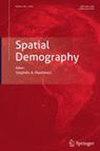美国大都市区人口距离剖面可视化再现框架
IF 1.1
Q3 DEMOGRAPHY
引用次数: 0
摘要
长期以来,城市人口学一直使用距离剖面图来探讨大都市地区的人口特征如何因其与城市核心的距离而变化。距离剖面可视化以图形方式说明了这些关系,在对城市地区进行探索性人口数据分析时非常有用。本文旨在演示如何在 R(一种免费开源的编程语言和数据分析环境)中可重复地构建距离剖面可视化。本文中的距离剖面可视化方法涉及以图形方式显示大都市人口普查区人口群体的位置商数与人口普查区中心点与其各自城市核心之间的距离之间的平滑关系。数据采集、分析和可视化均由 R 语言处理。在此框架中使用了 tidycensus、sf 和 ggplot2 R 软件包。教育程度的距离剖面可视化被用作示例,揭示了大都市教育程度的地理分布如何随时间和不同类型的大都市地区而变化。本文章由计算机程序翻译,如有差异,请以英文原文为准。
A Reproducible Framework for Visualizing Demographic Distance Profiles in US Metropolitan Areas
Distance profiles have long been used in urban demography to explore how demographic characteristics of metropolitan areas vary by distance from their urban cores. Distance profile visualizations graphically illustrate these relationships and are useful in exploratory demographic data analysis of urban areas. The purpose of this article is to demonstrate how to build distance profile visualizations reproducibly within R, a free and open-source programming language and data analysis environment. The approach to distance profile visualization in this article involves the graphical display of a smoothed relationship between the location quotient of a demographic group for a metropolitan Census tract and the distance between the tract centroid and its respective urban core. Data acquisition, analysis, and visualization are all handled in R. The tidycensus, sf, and ggplot2 R packages are featured in this framework. Distance profile visualizations for educational attainment are used as illustrative examples, and reveal how the geography of metropolitan educational attainment varies both over time and across different types of metropolitan areas.
求助全文
通过发布文献求助,成功后即可免费获取论文全文。
去求助
来源期刊

Spatial Demography
DEMOGRAPHY-
自引率
0.00%
发文量
12
期刊介绍:
Spatial Demography focuses on understanding the spatial and spatiotemporal dimension of demographic processes. More specifically, the journal is interested in submissions that include the innovative use and adoption of spatial concepts, geospatial data, spatial technologies, and spatial analytic methods that further our understanding of demographic and policy-related related questions. The journal publishes both substantive and methodological papers from across the discipline of demography and its related fields (including economics, geography, sociology, anthropology, environmental science) and in applications ranging from local to global scale. In addition to research articles the journal will consider for publication review essays, book reviews, and reports/reviews on data, software, and instructional resources.
 求助内容:
求助内容: 应助结果提醒方式:
应助结果提醒方式:


